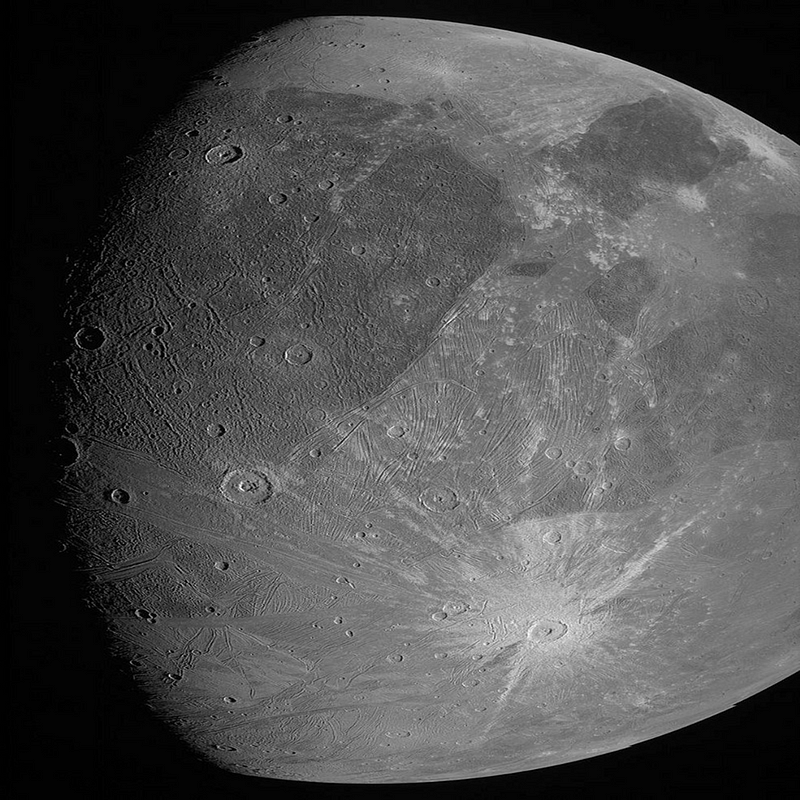Exciting Discovery: Water Vapor on Jupiter’s Moon Ganymede
Written on
Chapter 1: Ganymede's Fascinating Atmosphere
The recent findings regarding Ganymede, Jupiter's largest moon, have generated considerable excitement in the scientific community. This discovery, which indicates the presence of water vapor in its atmosphere, aligns with the theory that Ganymede may harbor a vast subsurface ocean capable of supporting extraterrestrial life.
NASA's groundbreaking Cassini mission, which concluded in 2017, played a pivotal role in enhancing our understanding of the planetary systems of both Jupiter and Saturn. Astronomers have meticulously examined the moons of these gas giants as potential habitats for life. While Titan, Saturn’s largest moon with its lakes of liquid methane, is often regarded as the foremost candidate, Ganymede has recently emerged as a noteworthy contender.
In 2023, the Europa Clipper mission is set to launch, aiming to confirm the existence of liquid water on Jupiter's fourth-largest moon, Europa, by investigating potential plumes in its atmosphere. Another promising moon, Enceladus, has been observed ejecting methane, a phenomenon not entirely explained by geothermal activities. Now, Ganymede joins this intriguing list.
According to NASA, this marks the first time scientists have identified water vapor in the atmosphere of Ganymede. The vapor is generated through sublimation—a process where solid ice converts directly into gas. This significant finding bolsters the hypothesis that Ganymede's extensive subsurface ocean could support life.

"Previously, we had only detected molecular oxygen, which is produced when charged particles erode the icy surface. The water vapor we are now measuring comes from the sublimation of ice due to thermal escape from warmer regions," stated Lorenz Roth, the study's lead researcher.

The researchers reached their conclusions by analyzing archival data from NASA's Hubble Space Telescope dating back to 1998, alongside recent observations from various instruments. Ganymede is a captivating moon—larger than Mercury and Pluto, it uniquely possesses its own magnetic field and contains more water than all of Earth's oceans combined. However, its surface remains frozen due to extremely low temperatures. If a subsurface ocean exists, it is likely located approximately 100 miles beneath the icy crust.
Hubble's Space Telescope Imaging Spectrograph provided crucial ultraviolet (UV) images of Ganymede, revealing vibrant ribbons of electrified gas known as auroral bands, akin to the northern and southern lights on Earth. The similarities in these UV observations were attributed to molecular oxygen (O2), but some features did not align with the expected emissions from a purely O2 atmosphere.
As scientists examined these discrepancies, they hypothesized that higher levels of atomic oxygen (O) might be responsible. A team from KTH Royal Institute of Technology in Stockholm, Sweden, led this recent investigation, which corroborated the findings from NASA's Juno mission and utilized data from Hubble's Cosmic Origins Spectrograph collected in 2018, as well as archival STIS images from 1998 to 2010.
Researchers scrutinized the distribution of the aurora in the UV images, noting that Ganymede's surface temperature fluctuates significantly throughout the day. Near noon, particularly around the equator, temperatures may rise enough to trigger sublimation, releasing small amounts of water vapor into the atmosphere. The variations observed in the UV images correspond directly to areas where water is expected to be present in the moon's atmosphere.
These discoveries could soon be validated by the European Space Agency's upcoming JUICE (JUpiter ICy moons Explorer) mission. Scheduled for launch in 2022 and set to arrive at Jupiter in 2029, JUICE will dedicate at least three years to conducting in-depth observations of Jupiter and its three largest moons, with a particular focus on Ganymede as a potential habitat.
Understanding the Jovian system will provide insights into how gas giants and their moons formed and evolved over time, as well as enhance our understanding of the habitability of Jupiter-like exoplanetary systems. The complete research was published in the Journal of Nature Astronomy.

Stay updated with the latest developments—consider joining my mailing list.
Chapter 2: Further Insights into Ganymede
The second video regarding Ganymede's atmosphere, titled "Water vapor in Jupiter moon Ganymede's atmosphere? Hubble finds evidence," expands on the implications of this remarkable discovery.